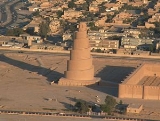
Malwiya
Encyclopedia
The Minaret of Samarra, also known as the Malwiya Minaret or Malwiya Tower is part of the Great Mosque of Samarra
in Samarra
, Iraq
. The mosque is one of the largest in the world, and was built by the Abbasid caliph Al-Mutawakkil
. The minaret was originally connected to the mosque by a bridge.
The minaret
or tower was constructed in 848 – 852 of sandstone
, and is unique among other minarets because of its ascending spiral conical design. 52 metres high and 33 metres wide at the base, the spiral contains stairs reaching to the top. The word "malwiya" translates as "twisted" or "snail shell".
At the top of the cone is a small cylindrical room with a six-metre radius. This room is decorated with eight arcs on the outside. Each arc is erected on two small brick posts.
Unlike most minarets, the Malwiya was not used for the "call to prayer"; its height made it impractical for such use. However, it is visible from a considerable distance in the area around Samarra and therefore may have been designed as a strong visual statement of the presence of Islam in the Tigris Valley.
Great Mosque of Samarra
The Great Mosque of Samarra is a 9th century mosque located in Samarra, Iraq. The mosque was commissioned in 848 and completed in 851 by the Abbasid caliph Al-Mutawakkil who reigned from 847 until 861....
in Samarra
Samarra
Sāmarrā is a city in Iraq. It stands on the east bank of the Tigris in the Salah ad-Din Governorate, north of Baghdad and, in 2003, had an estimated population of 348,700....
, Iraq
Iraq
Iraq ; officially the Republic of Iraq is a country in Western Asia spanning most of the northwestern end of the Zagros mountain range, the eastern part of the Syrian Desert and the northern part of the Arabian Desert....
. The mosque is one of the largest in the world, and was built by the Abbasid caliph Al-Mutawakkil
Al-Mutawakkil
Al-Mutawakkil ʻAlā Allāh Jaʻfar ibn al-Muʻtasim was an Abbasid caliph who reigned in Samarra from 847 until 861...
. The minaret was originally connected to the mosque by a bridge.
The minaret
Minaret
A minaret مناره , sometimes مئذنه) is a distinctive architectural feature of Islamic mosques, generally a tall spire with an onion-shaped or conical crown, usually either free standing or taller than any associated support structure. The basic form of a minaret includes a base, shaft, and gallery....
or tower was constructed in 848 – 852 of sandstone
Sandstone
Sandstone is a sedimentary rock composed mainly of sand-sized minerals or rock grains.Most sandstone is composed of quartz and/or feldspar because these are the most common minerals in the Earth's crust. Like sand, sandstone may be any colour, but the most common colours are tan, brown, yellow,...
, and is unique among other minarets because of its ascending spiral conical design. 52 metres high and 33 metres wide at the base, the spiral contains stairs reaching to the top. The word "malwiya" translates as "twisted" or "snail shell".
At the top of the cone is a small cylindrical room with a six-metre radius. This room is decorated with eight arcs on the outside. Each arc is erected on two small brick posts.
Unlike most minarets, the Malwiya was not used for the "call to prayer"; its height made it impractical for such use. However, it is visible from a considerable distance in the area around Samarra and therefore may have been designed as a strong visual statement of the presence of Islam in the Tigris Valley.
Damage
On April 1, 2005, the top of the Malwiya minaret was damaged by a bomb. Insurgents reportedly attacked the tower because U.S. troops had been using it as a lookout position. The blast removed pieces of brick from the top of the minaret along its spiral ramp.External links
- Ernst Herzfeld Papers, Records of Samarra Expeditions, Great Mosque of al-Mutawakkil Collections Search Center, S.I.R.I.S., Smithsonian Institution, Washington, D.C.
- Samarra - The Great Mosque

